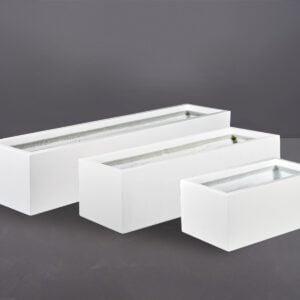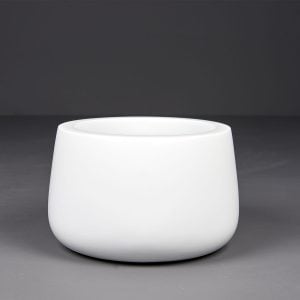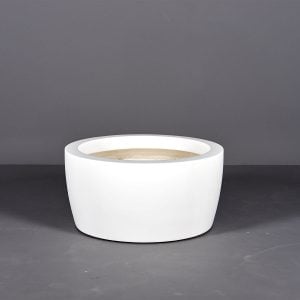- What is a Self-Watering Planter or Pot?
- The 10 Pros and Cons of Using a Self-Watering Pot
- Do-It-Yourself Self-watering Pots
- 5 Plants Best Suited for Self-Watering and 5 Great Planters to Match
- Planter Recommendation: Cuba Low Rectangular Planter
- Planter Recommendation: Short Hayden Tapered Round Planter
- Planter Recommendation: Montroy Cube Planter
- Planter Recommendation: Casablanca Bowl Planter
- Planters Etc is Here for All Your Planter Needs
The concept of self-watering planters is an appealing one. In an ideal world, it allows for residential and commercial spaces outfitted with lush greenery with little day-to-day watering work, taking a load of stress off planting season.
Self-watering containers claim to be convenient, water-saving, and water efficient, as well as resulting in healthier plants. While a self-watering system has many advantages over regular pots, there are cons to it as well. Let’s take a deep dive into this guide to self-watering planters.
What is a Self-Watering Planter or Pot?

As the name implies, self-watering planters and pots are plant containers that have a reservoir system in place to offer a steady supply of water to the plants. Of course, the self-watering container is unable to draw water magically from the water supply, the onus is still on the gardener to ensure the water reserves for the self-watering plants are full. If you want your own self-watering container, read on to find out exactly how self-watering planters work.
How Do Self-Watering Pots Work?

There are several types of self-watering containers, but they mostly work on the same basic principle. At the bottom of the self-watering planter, there is a water reservoir that supplies the potting soil of your planter to absorb water through capillary action (the wicking system). The soil wicks up water, and the damp soil and the plant roots absorb water from there.
What is Capillary Action and Why is it Important for Self-Watering Planters?

Capillary action is integral to self-watering planters – is the action or ‘wicking’ that takes place as the potting mix or soil draws water, similar to how a sponge absorbs water, overcoming gravity. This wicking action is caused by the intermolecular attraction of fluids together with the attractive forces between a liquid and an underlying solid.
The Common Features & Parts of a Self-Watering Planter

A self-watering pot may look like a normal pot, but it actually a complex container. The top portion of the self-watering container will contain the plant potting soil, while the bottom part usually contains the water reservoir. The water chamber varies in size according to the container size. Larger plants need bigger water chambers and larger containers. There is a small overflow hole, so that excess water can drain away from this overflow outlet, thereby avoiding over-watering.
What Do You Need to Do for the Self-Watering Containers?

Although there is a system in place for the soil in self-watering planters to wick water so that the plant roots absorb exactly how much water it needs – there is still work for you to do!
This is not a completely hands-off approach to gardening. Instead of having to pour water over the plant’s potting mix, you need to add water to the water reservoir. Depending on its size as well as how much water the plant needs, this task can be done as often as every day. You also need to check on the moisture level of the potting soil, too dry potting mix can affect the plants growing well, while too wet soil can cause the plant’s roots to develop root rot, which is a major plant health issue.
The 10 Pros and Cons of Using a Self-Watering Pot
While self-watering planters are convenient, they do not take all the guesswork out of growing plants. Let’s take a deeper look into the advantages and disadvantages of using self-watering pots.
5 Pros of Using a Self-Watering Planter
1. Increases Plant Health

The closed system of the self-watering planter also helps keep nutrients inside the potted plant, rather than have it leak out through drainage holes over time. This growing medium has more time to benefit from your liquid fertilizer or slow-release fertilizer, rather than needing you to top up the potting mix every growing season. This boosts nutrients for the plant’s leaves, which is great for growth and health!
Know more about the 3 plant growth stages.
2. Good for Plant Roots

The water reservoir supplies a consistent moisture level to the potting soil, ensuring that the plant roots have direct access to water through the adhesive force of the capillary action. The plants have the perfect level of water, and healthy root growth is easily achieved compared to normal pots.
3. Eco-Friendly

The way self-watering planters work is also sustainable and good for the environment. In general, self-watering pots help the plants to regulate how much water it needs through the attractive force capillary action of the potting soil. This means it’s harder to cause over-watering, which reduces the amount of water used.
4. Very Convenient for Busy People

Of course, one of the most important reasons for installing a self-watering planter setup is to achieve an easier and more straightforward way of looking after your favorite plants.
Apart from taking active watering off the daily agenda, it also allows the gardener to take time off for vacations without worrying about the plants.
5. Suitable for Commercial Gardens

Another great thing about having self-watering pots is that they can be used beyond residential gardens, they can be set up for office buildings, campuses, restaurants, and more.
This gives great convenience and flexibility when it comes to the care of the large gardens.
5 Cons of Using a Self-Watering Planter
1. Not Great for Thirsty Plants

One huge caveat to using self-watering pots is that it is not suitable for some plants. Most plants do okay with the self-watering planter system, but there are exceptions!
Self-watering planters are not suitable for cacti, succulents, orchids, and other plants that need to have their potting soil dry out between waterings. Root rot can occur with the constant moisture of these types of plants.
Find out which 5 succulents are best for bathrooms!
Similarly, thirsty plants that need their potting mix to be very moist may also struggle with the self-watering pot set-up. It can never properly soak a water-hungry plant such as aquatic plants, such as the Lotus, or the Java Fern.
2. Not Suitable for Humid Climates

Especially when placed outdoors, self-watering planters might not function as thought when in a hot and humid environment. The self-watering pot will easily become waterlogged by the high levels of humidity and rain. While an overflow hole can help, it is unable to prevent excess water from entering the potting soil, which causes the plant to sit in very wet soil rather than a damp mix.
3. Can Breed Mosquitos

If mosquitos are a problem in your area, self-watering planters may not be suitable. The water reservoir can become a breeding ground for mosquitoes that like stagnant and still water. This would require more checking from the gardener.
4. Higher Price Point

Self-watering planters retail at a higher price point than normal pots. This is not surprising as they require many different parts to run effectively.
5. Very Limited Design and Style Selection

While the market for self-watering pots has grown exponentially in recent years, it is still a very limited selection compared to the different pots of the regular variety you can find off the shelf.
This is especially problematic for larger-scale gardens, such as those in restaurants, hotels, offices, etc. The lack of design styles, colors, shapes, and even sizes for self-watering pots makes it difficult for the landscape architect to create a cohesive look for the property.
Do-It-Yourself Self-watering Pots

One of the biggest concerns when it comes to selecting self-watering planters over normal planters for your project is the lack of design styles. With Planters Et Cetera offering a stunning collection of fiberglass pots in both traditional and modern designs, you can have the best of both worlds by making them into self-watering planters. There are two ways to do this, one is via a readily available conversion kit, and the other method is to do it completely by yourself.
Using a Conversion Kit

The simplest way to convert any regular planter into a self-watering pot is with a conversion kit of self-watering inserts. With the structure pre-made for you, all you have to do is to put the piece at the bottom of your desired beautiful planter, before filling it with potting soil and the plant.
The conversion kit is generally a disc-shaped water reservoir with a PVC pipe attached, as well as a water level indicator. Use the pipe to add liquid fertilizers and water when necessary.
Our pick: Gardener’s Supply Self-Watering Pot Reservoir
DIY Self-Watering Pots

If you rather create the self-watering system yourself. Here is the list of items you need:
- Planter
- Container that fits into the bottom of the planter
- Small basket or pot with holes for the soil foot
- Narrow tubes
- Coffee filter, landscape fabric, or mesh to cover the pipe
- Wicking material e.g. string
- Drill
1. Construct the Water Reservoir
First, construct the water reservoir, which is housed by the container. Cut a small hole at the hold of the container, making sure the small basket or pot fits in there neatly. The basket acts as the ‘soil foot’ i.e. the access point where the soil can draw water from the water chamber. Place this at the bottom of the planter.
2. Insert the Watering Tube
Second, insert the watering tube – make sure the tube reaches from the water chamber to above the soil. This allows you to add water to the chamber when necessary. Cover both ends of the pipe with mesh to ensure nothing but water goes through the pipe.
3. Drill Overflow Holes
Drill drainage holes into the sides of the planter – this should be at the same height as the watering chamber. This allows the extra water to flow out of the planter instead of soaking up the soil in your self-watering pot
4. Fill the Foot with Damp Soil
Place the wicking material inside the foot, making sure it reaches the soil part to the water part. Then fill the foot with damp soil, making sure you pack it in tightly, then proceed to fill the rest of the planter with good potting soil. Do not pack this part too tightly to leave space for air pockets.
5. Plant the Plant
Gently insert your plant into the soil. Generously water the entire planter from the top. Continue to water for a week or two as the plant is getting used to the self-watering planter. After which, just make sure the water reservoir is always topped up.
5 Plants Best Suited for Self-Watering and 5 Great Planters to Match
Armed with the knowledge that any type of planter can be converted into self-watering pots, here are 5 wonderful plants that are suitable to grow in self-watering planters!
1. Cherry Tomato Plant
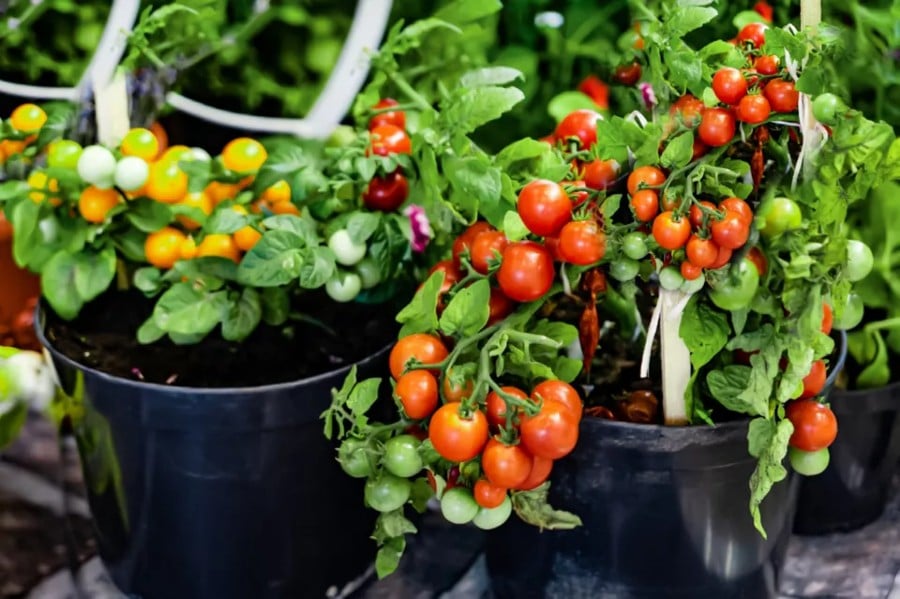
It is always a lovely idea to grow vegetables and fruits, especially if you are a restauranteur. Cherry tomatoes are easy to grow and tend to thrive in big pots, this is because the bigger space allows for more soil to absorb water.
Check out our beginner’s guide to growing vegetables.
Cherry tomato plants love water, and under-watering can cause blossom end rot and split tomatoes. Over-watering can also cause similar results. Therefore these plants do best in a moist self-watering growing bed.
Planter Recommendation: Cuba Low Rectangular Planter
One of the newest additions to our handsome collection of fiberglass planters, the Cuba planter is fantastic for growing vegetables. The interior of each planter in this collection is 12 inches deep and comes in four sizes. Your cheery tomato plants will be happy as a clam growing in a planter like the Cuba planter.
2. Venus Flytrap

A Venus Flytrap is always a great conversation starter! Why not grow these interesting plants in your home or office?
This fascinating addition to your garden would do well in a self-watering planter and also help with pest control.
Related Article: Carnivorous Plants That Eat Bugs
Planter Recommendation: Short Hayden Tapered Round Planter
The Hayden is simply a good-looking container! A classic bowl shape that fits into any contemporary design aesthetic.
Go for the 7-inch deep option as Venus Flytraps do not need great depths. The flat opening of the planter also allows the plant to grow wide as it tends to hug the ground.
3. African Violets

These cheerful brightly colored flowering plants are basically built for self-watering pots. It is no wonder they are always on the recommended list of plants for self-watering.
Small houseplants, that produce clusters of white, blue, or purple flowers over fuzzy leaves, like moisture on their top, but also need the top of the soil to be dry before more water is added. Therefore self-watering planters are perfect as the top never gets wet.
4. Peace Lily
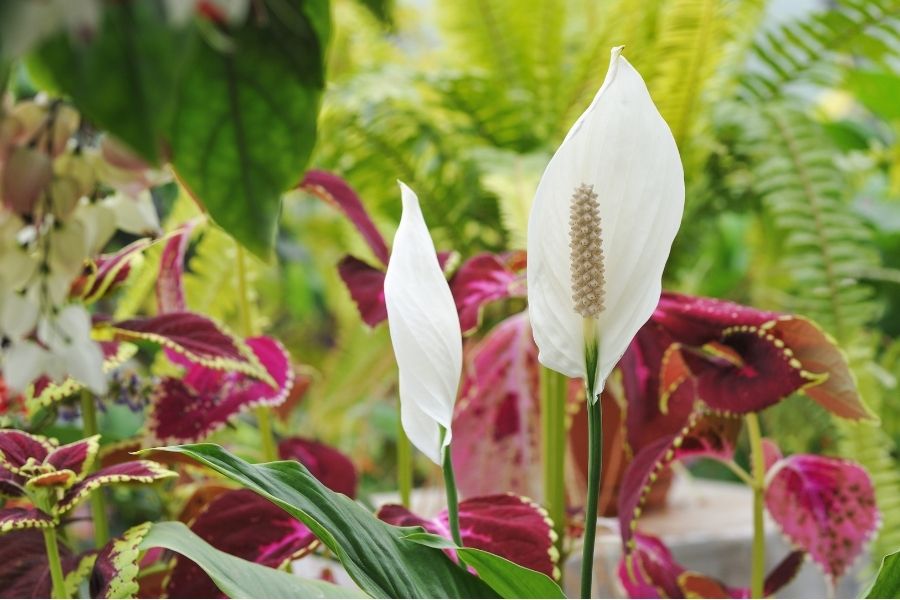
If you are up for a green thumb challenge, take on the Peace Lily. Many gardeners find it hard to encourage this plant to bloom.
A self-watering planter can actually help with this! It allows the soil to regulate the amount of moisture, avoiding watering mistakes and overly wet potting mix.
Planter Recommendation: Montroy Cube Planter
A cube planter is always a classic and the Montroy does it better than any other pot! This elegant square planter has an understated elegance and will add beauty to any space.
For the Peace Lily, choose the Montroy in its 12-inch size – roomy enough to house the self-watering base while small enough to keep the plant as cozy as it likes.
5. Monstera

A crowd favorite, the Monstera plant is widely seen in residential and commercial gardens. These lush green plants thrive in a self-watering setup.
They need soil conditions that are slightly moist. However, be sure to check the pot occasionally so that it’s not getting too damp.
Planter Recommendation: Casablanca Bowl Planter
Monsteras are growers! They need to be repotted every two to three years. A baby Monstera needs a planter of 8 inches, while a mature one might need a planter two feet large.
The Casablanca is the suggested planter for Monsteras, coming in 4 sizes, there will be one perfect for your plant. Featuring a sleek and sophisticated bowl shape, this planter fits in well in hotel lobbies or living rooms.
Planters Etc is Here for All Your Planter Needs

Planters Et Cetera is all about connecting with nature, we want plants and foliage to become part of our urban everyday life, whether you are in the home or office, whether it is for an indoor or outdoor space
To this end, we understand everything there is to know about planters. It is our firm belief that fiberglass is the superior material for plant pots. They are durable, lightweight, weather-resistant, and also design-friendly. What else could you ask for?
Here at Planters Et Cetera, we maintain a huge inventory of fiberglass pots and planters with over 70 different styles, and all are painted to order in your choice of 18 colors. Made with maximum strength resin and finished with UV-protected automotive-grade paint, you can be assured that we have gone every step of the way to ensure these planters are manufactured with the highest quality materials available and to top industry standards.
Read up on how to choose the right planter color.
These beautiful planters can withstand extreme temperatures making them perfect for outdoor applications, and their flawless appearance also makes them ideal for indoor decorative use.
Unlike other pots, there is no worry about the fiberglass material being toxic for plants, especially with your DIY self-watering setup, no harmful substances will be wicked up from our planters.
Each and every one of our fiberglass planters come with a three-year warranty. So contact us today and let us know more about your project, we are always happy to chat!

